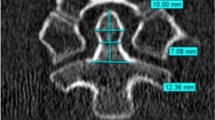Abstract
During skeletal development the two ossification centers of the odontoid process are separated from the corpus of the axis by a subdental synchondrosis. This synchondrosis is thought to close and disappear spontaneously in adolescence although this has never been studied in detail. The basis of the dens is of clinical relevance as type II dens fractures are located here. To characterize the morphological architecture of the axis with particular attention to the subdental synchondrosis, the complete axis was harvested from thirty age-matched and gender-matched patients of the three different age groups at autopsy. The subdental synchondrosis and the bone structure of the dens, the basis of the dens and the body of C2 were analyzed by radiography, histology and quantitative histomorphometry. At the macroscopic level the persistency of the subdental synchondrosis in the adult cervical spine was detected in 87% (26 of 30) of the specimens. Histomorphometry revealed a residual disc blastema with an average size of 25.8% of the sagittal depth of the basis of the dens at this level. Bony integration of the synchondrosis was poor throughout all ages. Histologically a cartilaginous matrix composition of the subdental synchondrosis persisted throughout all groups. The trabecular microarchitecture demonstrated a significant reduction of bone volume and trabecular number as well as an increased trabecular separation within the basis of the dens as compared to the corpus or the dens of C2. This histomorphometric data regarding a poor integration of the synchondrosis into the trabecular network and the reduced bone mass within the basis of the dens might offer a previously underestimated explanation for the occurrence of type II dens fractures and their association with pseudoarthrosis, respectively.




Similar content being viewed by others
References
Amling M, Hahn M, Wening VJ et al (1994) The microarchitecture of the axis as the predisposing factor for fracture of the base of the odontoid process. J Bone Joint Surg Am 76A:1840–1846
Amling M, Pösl M, Wening VJ et al (1995) Structural heterogeneity within the axis: the main cause in the etiology of dens fractures. J Neurosurg 83:330–335
Anderson LD, D’Alonzo RT (1974) Fractures of the odontoid process of the axis. J Bone Joint Surg Am 56:1663–1674
Appuzo ML, Heiden JS, Weiss MH et al (1978) Acute fractures of the odontoid process: an analysis of 45 cases. J Neurosurg 48:85–91
Blauth M, Schmidt U, Otte D, Krettek C (1996) Fractures of the odontoid process in small children: biomechanical analysis and report of three cases. Eur Spine J 5:63–70
Blauth M, Richter M et al (1999) Operative versus nonoperative treatment of odontoid nonunions. How dangerous is it not to stabilize a non-union of the dens? Chirurg 70:1225–1238
Böhler J (1982) Anterior stabilization for acute fractures and non-unions of the dens. J Bone Joint Surg Am 64:18–27
Castellana C, Kósa F (1999) Morphology of the cervical vertebrae in the fetal-neonatal human skeleton. J Anat 194:147–152
Clark CR, Igram CM, El-Khoury GY, Ehara S (1988) Radiographic evaluation of cervical spine injuries. Spine 13:742–747
Connolly B, Emery D, Armstrong D (1995) The odontoid synchondrotic slip: an injury unique to young children. Pediat Radiol 25:129–133
Dunn ME, Seljeskog EL (1986) Experience in the management of odontoid process injuries: an analysis of 128 cases. Neurosurgery 18:306–310
Ehara S, El-Khoury GY, Clark CR (1992) Radiologic evaluation of dens fracture. Role of plain radiography and tomography. Spine 17:475–479
Hadley MN, Browner C, Sonntag VKH (1985) Axis fractures: a comprehensive review of management and treatment in 107 cases. Neurosurgery 20:911–916
Hart R, Saterbak A, Rapp T, Clark C (2000) Nonoperative management of dens fracture nonunion in elderly patients without myelopathy. Spine 25:1339–1343
Keller J, Mosdal C (1990) Traumatic odontoid epiphysiolysis in an infant fixed in a child’s car seat. Injury 21:191–192
Lennarson PJ, Mostafavi H, Traynelis VC, Walters BC (2000) Management of type II dens fractures: a case-control study. Spine 25:1234–1237
McGrory BJ, Klassen RA, Chao EY, Staeheli JW, Weaver AL (1993) Acute fractures and dislocations of the cervical spine in children and adolescents. J Bone Joint Surg Am 75:988–995
Nachemson A (1960) Fracture of the odontoid process of the axis. A clinical study based on 26 cases. Acta Orthop Scand 29:185–217
Nepper-Rasmussen J (1989) CT of dens axis fractures. Neuroradiology 31:104–106
Ogden JA (1984) Radiology of the postnatal skeletal development. XII. The second cervical vertebra. Skeletal Radiol 12:169–177
Parfitt AM, Drezner MK, Glorieux FH et al (1987) Bone histomorphometry: standardization of nomenclature, symbols, and units. Report of the ASBMR histomorphometry nomenclature commitee. J Bone Min Res 6:595–610
Puttlitz CM, Goel VK, Clark CR et al (2000) Pathomechanisms of failures of the odontoid. Spine 25:2868–2876
Sasso RC (2001) C2 Dens fractures: treatment options. J Spin Disord 14:455–463
Schiff DC, Parke W (1973) The arterial supply of the odontoid process. J Bone Joint Surg Am 55:1450–1456
Vining DJ, Benzel EC, Orrison W (1992) Childhood odontoid fractures evaluated with computerized tomography. J Neurosurg 77:795–798
Acknowledgements
The manuscript submitted does not contain information about medical devices or drugs. No funds were received in support of this work. No benefits in any form have been or will be received from a commercial party related directly or indirectly to the subject of this article.
Author information
Authors and Affiliations
Corresponding author
Additional information
Matthias Gebauer and Christian Lohse contributed equally to this study and therefore share first authorship.
Rights and permissions
About this article
Cite this article
Gebauer, M., Lohse, C., Barvencik, F. et al. Subdental synchondrosis and anatomy of the axis in aging: a histomorphometric study on 30 autopsy cases. Eur Spine J 15, 292–298 (2006). https://doi.org/10.1007/s00586-005-0990-7
Received:
Revised:
Accepted:
Published:
Issue Date:
DOI: https://doi.org/10.1007/s00586-005-0990-7




